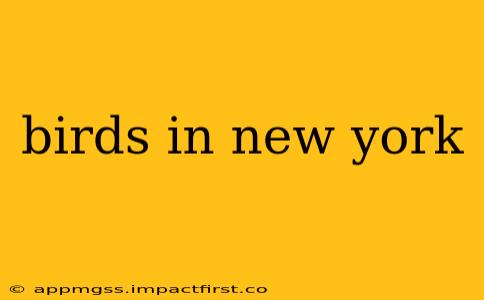New York City, a concrete jungle teeming with millions of people, might seem an unlikely haven for birds. Yet, surprisingly, the five boroughs are home to a diverse and vibrant avian population, attracting both seasoned birdwatchers and casual observers alike. From the bustling parks of Manhattan to the quieter wetlands of Staten Island, a fascinating array of feathered friends call New York home, offering a unique blend of urban and natural wildlife experiences. This guide explores the rich avian life of New York City, covering everything from common species to rarer sightings, and answering some frequently asked questions.
What are some common birds in New York City?
New York City's birdlife reflects its varied habitats. Among the most common species you'll encounter are:
- Rock Pigeons: Ubiquitous in urban environments, these birds are highly adaptable and thrive in the city's diverse food sources.
- House Sparrows: Another common sight, these small, brown birds are frequently found in urban areas, often nesting in buildings.
- American Robins: These cheerful red-breasted birds are a welcome sign of spring and are regularly seen in parks and gardens across the city.
- Northern Cardinals: With their vibrant red plumage (males) and distinctive crests, these birds are a delightful addition to the city's parks and green spaces.
- Mourning Doves: These gentle doves, with their soft cooing calls, are a common sight in both urban and suburban areas.
- European Starlings: Though invasive, these birds are extremely prevalent in large numbers across the city.
- House Finches: These small, colorful finches frequent bird feeders and are relatively easy to spot in parks and residential areas.
Many other species, including various types of woodpeckers, warblers, and sparrows, can also be observed depending on the season and location.
What are some rare birds that have been sighted in New York City?
While common birds are frequent visitors, rarer sightings do occur, often attracting considerable attention from birding enthusiasts. These can include migrating species that briefly stop in the city, or unusual vagrants that stray far from their typical range. Specific species and sightings vary significantly based on the time of year. Consulting local birding resources and online forums can provide the most up-to-date information on recent rare bird sightings.
Where are the best places to birdwatch in New York City?
Several locations in New York City provide exceptional opportunities for birdwatching:
- Central Park: This iconic park boasts a remarkable diversity of bird species, thanks to its varied habitats, including woodlands, meadows, and bodies of water.
- Prospect Park (Brooklyn): Another large urban park with a rich avian population, Prospect Park offers a more tranquil birding experience compared to the bustling Central Park.
- Jamaica Bay Wildlife Refuge (Queens): This coastal refuge provides a crucial habitat for migratory birds and offers excellent opportunities for observing a variety of waterfowl and shorebirds.
- Inwood Hill Park (Manhattan): This park’s unique wooded areas offer a more natural environment, attracting different species compared to other Manhattan locations.
- Governors Island: This car-free island offers unique habitats and amazing views, creating an ideal birding experience.
These are just a few examples; many other parks and green spaces throughout the five boroughs offer great chances for birdwatching.
What is the best time of year to birdwatch in New York City?
Spring and fall migrations are peak seasons for birdwatching in New York City. During these times, many species pass through the city, increasing the variety and numbers of birds visible. However, you can spot interesting birds throughout the year, with resident species providing consistent opportunities for observation.
What are some tips for birdwatching in New York City?
- Bring binoculars: Essential for getting a closer look at birds.
- Check local bird sightings: Utilize online resources and birding apps to stay updated on recent sightings in your chosen location.
- Be patient and observant: Birds can be elusive, so patience is key.
- Respect wildlife: Maintain a safe distance from birds and their nests.
- Dress appropriately: Wear comfortable clothing and shoes suitable for walking.
- Consider joining a birding group or tour: This can be a fantastic way to learn more and improve your bird identification skills.
Conclusion
New York City's avian life offers a surprising and rewarding experience for bird enthusiasts of all levels. By exploring the various parks, refuges, and green spaces across the five boroughs, you'll discover a fascinating world of feathered friends coexisting with the urban landscape. So, grab your binoculars, and get ready to explore the diverse birdlife that thrives in the heart of the city that never sleeps!
